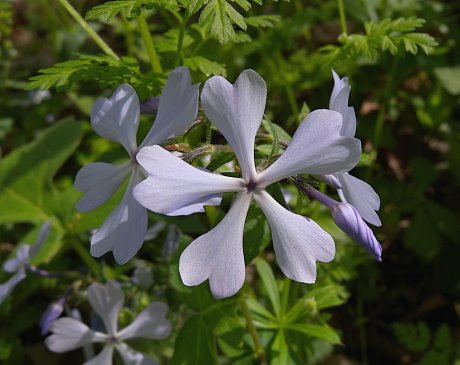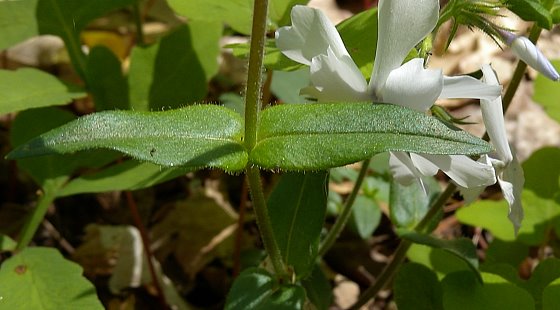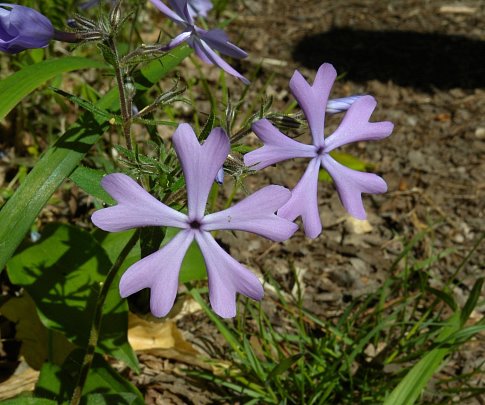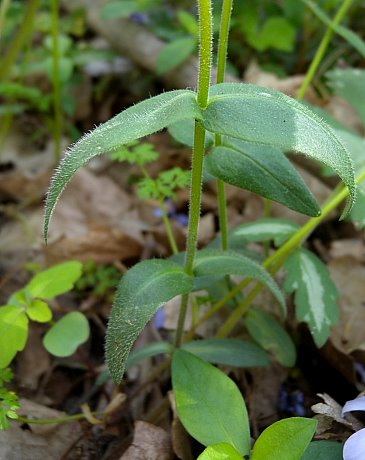
The central stem of each fertile shoot terminates in a rounded cluster of flowers about 2-3½" across. Each flower is about 1" across, consisting of a corolla with 5 spreading lobes, a calyx with 5 teeth, 5 inserted stamens, and a pistil. The corolla can be light blue-violet, lavender, pink, or white and its throat consists of a narrow opening. The corolla base is narrowly tubular. For this subspecies of Woodland Phlox (Phlox divaricata divaricata), the corolla lobes are oblanceolate, but shallowly notched at their tips to a depth of 1-3 mm. The sepals are light green to purple and glandular-hairy. The teeth of sepals are linear in shape; they extend to nearly the entire length of the sepals. The branches and pedicels of the inflorescence are light green to purple, terete, and glandular-hairy. The blooming period occurs from mid-spring to early summer, lasting about 1 month. The flowers have a pleasant fragrance. Afterwards, the flowers are replaced by ovoid seed capsules about 4 mm. in length. Each capsule contains several small seeds. The root system is stoloniferous, forming small clonal colonies of plants.

Cultivation: The preference is dappled sunlight to light shade, mesic conditions, and a rich loam with abundant organic matter. Fertile shoots die down shortly after flowering, while infertile shoots can retain their leaves into the winter.
Range & Habitat: This subspecies of Woodland Phlox (Phlox divaricata divaricata) has not been observed in Illinois, even though it occurs across the border in Indiana (see Distribution Map). For this wildflower, the typical subspecies has a more eastern range, while ssp. laphamii has a more western range (which includes Illinois). The ranges of these two subspecies overlap in Indiana. It is possible, however, that isolated populations of the typical subspecies occur in Illinois, but they have not been reported. Habitats include rich woodlands, open woodlands, and areas adjacent to woodland paths. In these wooded areas, Acer saccharum (Sugar Maple) and other deciduous trees are typically dominant. Woodland Phlox is one of the spring wildflowers that is vulnerable to habitat destruction and invasion of wooded areas by Garlic Mustard (Alliaria petiolata).

Faunal Associations: The flowers of Woodland Phlox are cross-pollinated by bumblebees, bee flies (Bombyliidae), butterflies (especially swallowtails), skippers, and moths (including Hummingbird Clearwing & Sphinx moths). These insect obtain nectar from the flowers. Other insects feed destructively on Woodland Phlox and other Phlox species. These species include the leaf beetles Galeruca externa and Scelolyperus cyanellus, the stem-boring larvae of the long-horned beetle Oberea flavipes, Lopidea davisi (Phlox Plant Bug), and caterpillars of such moths as Heliothis turbatus (Spotted Straw) and Papaipema nebris (Stalk Borer Moth); see Clark et al. (2004), Yanega (1996), Knight (1941), Covell (1984/2005), and Eastman (1992) for more information. In addition, White-tailed Deer browse on the foliage of Woodland Phlox sparingly.

Photographic Location: A deciduous woodland at the Pine Hills State Nature Preserve in west-central Indiana.
Comments: This is another attractive wildflower that blooms during the spring in deciduous woodlands. The typical subspecies of Woodland Phlox (Phlox divaricata divaricata) is very similar in appearance to Phlox divaricata laphamii, except the corolla lobes of the typical subspecies have notched tips, while the corolla lobes of ssp. laphamii have rounded or bluntly angular tips. In addition, the typical subspecies is more likely to produce pinkish flowers than spp. laphamii. Where their ranges overlap, it is possible to find some evidence of hybridization between these two subspecies.